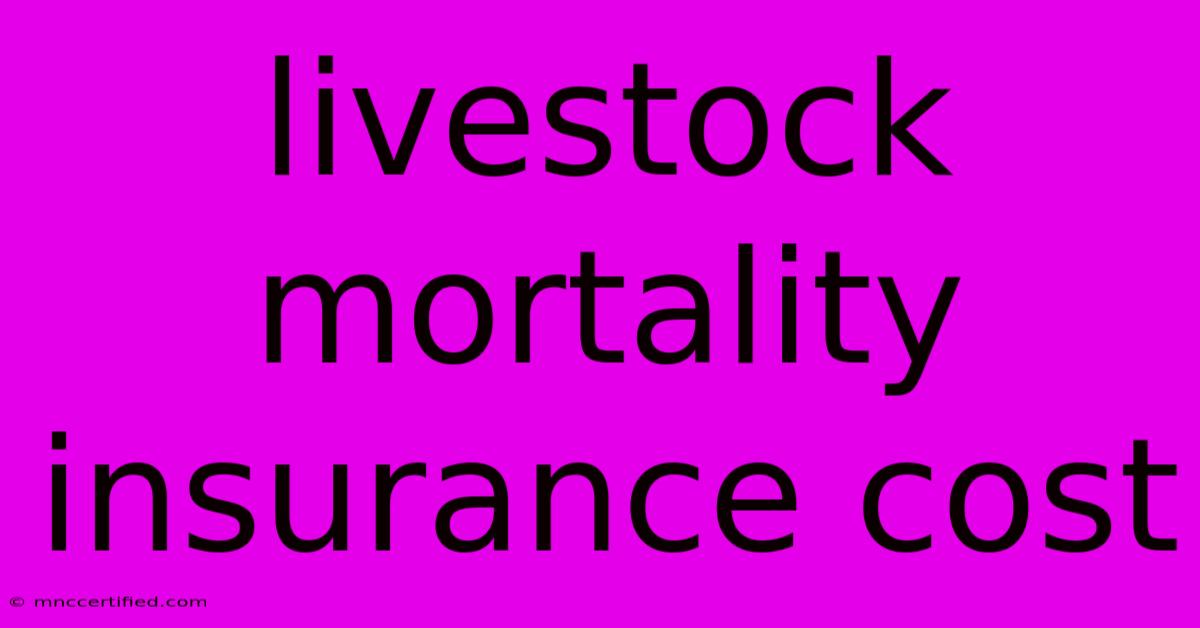Livestock Mortality Insurance Cost

Table of Contents
Livestock Mortality Insurance Cost: A Comprehensive Guide
Losing livestock can be a devastating blow to any farming operation, impacting not only your emotional well-being but also your financial stability. That's where livestock mortality insurance comes in. But how much does it cost? This comprehensive guide breaks down the factors influencing livestock mortality insurance premiums and helps you understand what to expect.
Understanding Livestock Mortality Insurance
Livestock mortality insurance protects farmers against financial losses resulting from the unexpected death of their animals. This crucial coverage can safeguard your business from unforeseen events like disease outbreaks, accidents, or natural disasters. The policy typically covers a percentage of the animal's value, helping you offset the cost of replacement or lost income.
Types of Livestock Covered
Insurance providers offer coverage for a wide range of livestock, including:
- Cattle: Beef cattle, dairy cattle
- Sheep: Breeding ewes, lambs
- Goats: Dairy goats, meat goats
- Pigs: Breeding sows, piglets
- Poultry: Chickens, turkeys, ducks
The specific animals covered and the terms of the policy will vary depending on the insurer and the individual farmer's needs.
Factors Affecting Livestock Mortality Insurance Cost
Several factors influence the cost of your livestock mortality insurance premium. Understanding these factors can help you shop around for the best deal and make informed decisions about your coverage.
1. Type and Number of Animals
The type of livestock you own significantly impacts the cost. Higher-value animals, such as purebred breeding stock, will generally command higher premiums than commercial animals. Similarly, the number of animals you insure directly influences the overall cost; insuring a larger herd will naturally be more expensive than insuring a smaller one.
2. Location and Risk Factors
Your geographical location plays a crucial role. Areas prone to severe weather events, disease outbreaks, or other risks will have higher premiums to reflect the increased likelihood of claims. Specific risks on your farm, such as proximity to wildlife or the presence of certain diseases, can also influence the cost.
3. Age and Health of Animals
Younger animals typically have lower premiums than older animals, as they are generally healthier and less prone to age-related illnesses. The overall health and condition of your livestock at the time of insurance application will be assessed, and pre-existing conditions could impact the premium or even lead to exclusion from coverage.
4. Policy Coverage and Deductible
The level of coverage you choose influences the premium. Higher coverage percentages will naturally result in higher premiums. Your chosen deductible also impacts the cost; a higher deductible will generally lower your premium, but you'll pay more out-of-pocket in the event of a claim.
5. Insurer and Policy Terms
Different insurance providers have different pricing structures, policy terms, and underwriting guidelines. Comparing quotes from multiple insurers is crucial to finding the most competitive rate and the policy best suited to your needs. Pay close attention to the fine print, including exclusions and limitations.
Getting the Best Rate on Livestock Mortality Insurance
- Shop around: Compare quotes from several insurers to find the best price and coverage options.
- Improve your risk management: Implement good herd management practices, maintain accurate records, and take preventative measures to minimize risks. This can lead to lower premiums.
- Consider bundling: Some insurers offer discounts for bundling livestock mortality insurance with other farm insurance policies, such as property or liability insurance.
- Negotiate: Don't be afraid to negotiate with insurers to find a rate that works for your budget.
Conclusion
The cost of livestock mortality insurance varies widely depending on numerous factors. By understanding these factors and taking proactive steps to manage risk, farmers can secure affordable and comprehensive coverage to protect their livelihoods. Remember, proactive planning and careful comparison shopping are key to securing the best possible insurance policy at a price that fits your budget. Always read the policy thoroughly and understand the terms and conditions before signing any agreement.

Thank you for visiting our website wich cover about Livestock Mortality Insurance Cost. We hope the information provided has been useful to you. Feel free to contact us if you have any questions or need further assistance. See you next time and dont miss to bookmark.
Featured Posts
-
Chris Mc Causlands Impressive Strictly Score
Nov 17, 2024
-
Ronaldo Retirement Hint Portugal Record Win
Nov 17, 2024
-
Job In Home Without Any Investment
Nov 17, 2024
-
Jobs At National General Insurance
Nov 17, 2024
-
Free Lsu Vs Florida Game
Nov 17, 2024